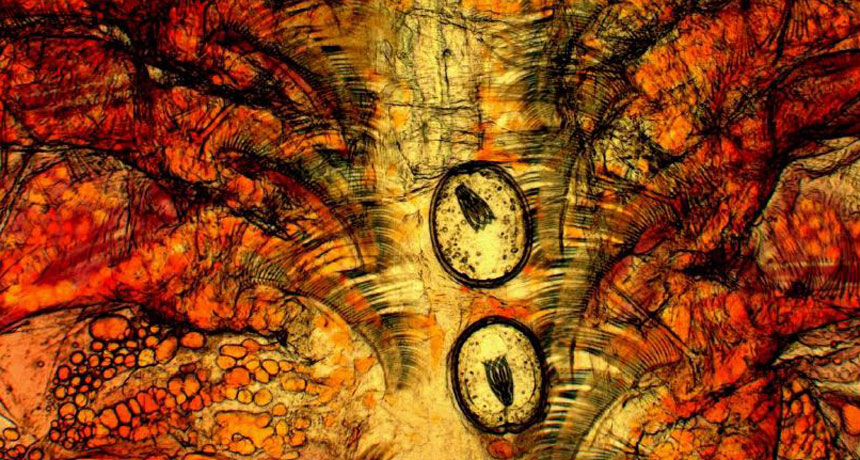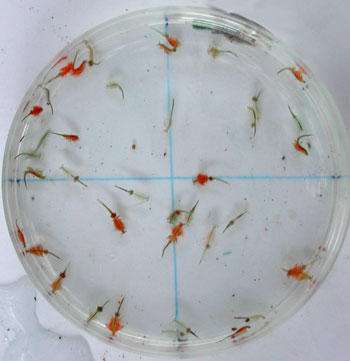Parasites give brine shrimp super powers
When infected with worms, tiny crustaceans survive better in toxic waters

The tissue of brine shrimp turns red after it is infected with parasitic tapeworms. This color is caused by an increase in carotenoids, a type of pigmented chemical. The parasites also increase the ability of the brine shrimp to survive waters laced with toxic arsenic, a new study finds.
Sample provided by Marta Sánchez; photography by Javier Díaz Real (CC BY)
Being infected with a parasite is usually not good news. These critters live in or on another. And they can sicken or even kill their hosts. When an animal has to deal with both a parasite and pollution, these stressors can add up. But that isn’t true for Artemia brine shrimp, a new study finds. Infection with parasitic worms actually boosts the ability of these animals to survive in water laced with toxic arsenic.
Marta Sánchez works for the Spanish National Research Council in Seville. As an ecologist, she is interested in how living things relate to one another and to their environment. She studies the role of parasites. Her team was curious about brine shrimp because they are key players in their ecosystem. (That term refers to the collection of plants, animals and other things that live nearby.) Brine shrimp are crustaceans (Krus-TAY-shuns). They are eaten by many waterbirds, including flamingos. And those brine shrimp can ferry pollutants and parasites into the birds.
When brine shrimp are infected by parasites called tapeworms, they turn red. This makes them easy for birds to see. It also makes it easy for scientists to pick out the brine shrimp infected with worms..

And that’s what Sánchez and her colleagues did.
They collected brine shrimp from the area where the Odiel and Tinto rivers in southwest Spain join before running into the Atlantic Ocean. Mining activities have tainted these waters with arsenic and toxic heavy metals. All of these elements are considered pollutants.
In the lab, the researchers separated brine shrimp into two groups. Some were infected with tapeworms; others were not. Then the scientists ran tests to see how well the tiny animals survived in polluted water.
As the level of arsenic in the water increased, so did the number of brine shrimp that died. But brine shrimp that were infected with worms survived better than uninfected ones did.
The researchers then ran their tests again. They were curious about how climate change might affect the brine shrimp’s survival in polluted water. So this time they used warmer water. Again, worm infection seemed to protect the brine shrimp from the effects of arsenic.
The scientists reported their results March 3 in PLOS Pathogens.
It may seem strange that parasites would protect an animal’s health. But causing its host to die quickly is not good for a parasite. It needs its host to stay alive long enough for the stowaway to reproduce and then move on to a new host. If that first host dies too quickly, so will the parasite. So helping brine shrimp survive polluted waters may be in the worms’ best interest.
The worms may be helping to changing how their hosts deal with pollution and the stress it can cause. When the researchers compared infected and uninfected brine shrimp, they found differences. Infected brine shrimp had more droplets of lipids — fats — in their tissues. The lipid droplets may help the brine shrimp sock arsenic away so that it can’t harm them.
Infected brine shrimp also produced more antioxidants. These are chemicals that protect an organism from the damaging effects of stress on cells. Stressors can include things like exposure to poisons. In the brine shrimp, “Infected individuals were better than uninfected individuals at coping under polluted conditions,” Sánchez reports.
His team cannot say whether the beneficial link between tapeworms and brine shrimp is special to this spot in Spain. “What we can say,” Sánchez notes, is that the reddening of organisms infected with tapeworms has been seen at sites in other countries. For that reason, she suspects brine shrimp in other places would show similar effects.
Power Words
(for more about Power Words, click here)
antioxidant Any of many chemicals that can shut down oxidation — a biologically damaging reaction. They do this by donating an electron to a free radical (a reactive molecular fragment) without becoming unstable. Many plant-based foods are good sources of natural antioxidants, including vitamins C and E.
arsenic A highly poisonous metallic element. It occurs in three chemically different forms, which also vary by color (yellow, black and gray). The brittle, crystalline (gray) form is the most common. Some manufacturers tap its toxicity by adding it to insecticides.
brine shrimp Water-dwelling crustaceans in the genus Artemia. Some breeds of brine shrimp are sold as novelty items known as “sea monkeys.”
cell The smallest structural and functional unit of an organism. Typically too small to see with the naked eye, it consists of watery fluid surrounded by a membrane or wall. Animals are made of anywhere from thousands to trillions of cells, depending on their size.
climate change Long-term, significant change in the climate of Earth. It can happen naturally or in response to human activities, including the burning of fossil fuels and clearing of forests.
crustaceans Hard-shelled water-dwelling animals including lobsters, crabs and shrimp.
ecology A branch of biology that deals with the relations of organisms to one another and to their physical surroundings. A scientist who works in this field is called an ecologist.
ecosystem A group of interacting living organisms — including microorganisms, plants and animals — and their physical environment within a particular climate. Examples include tropical reefs, rainforests, alpine meadows and polar tundra.
element (in chemistry) Each of more than one hundred substances for which the smallest unit of each is a single atom. Examples include hydrogen, oxygen, carbon, lithium and uranium.
environment The sum of all of the things that exist around some organism or the process and the condition those things create for that organism or process. Environment may refer to the weather and ecosystem in which some animal lives, or, perhaps, the temperature, humidity and placement of components in some electronics system or product.
host (in biology and medicine) The organism in which another lives. Humans may be a temporary host for food-poisoning germs or other infective agents.
infection A disease that can spread from one organism to another.
lipid A type of fat.
molecule An electrically neutral group of atoms that represents the smallest possible amount of a chemical compound. Molecules can be made of single types of atoms or of different types. For example, the oxygen in the air is made of two oxygen atoms (O2), but water is made of two hydrogen atoms and one oxygen atom (H2O).
parasite An organism that gets benefits from another species, called a host, but doesn’t provide it any benefits. Classic examples of parasites include ticks, fleas and tapeworms.
pathogen An organism that causes disease.
pigment A material, like the natural colorings in skin, that alter the light reflected off of an object or transmitted through it. The overall color of a pigment typically depends on which wavelengths of visible light it absorbs and which ones it reflects. For example, a red pigment tends to reflect red wavelengths of light very well and typically absorbs other colors. Pigment also is the term for chemicals that manufacturers use to tint paint.
pollutant A substance that taints something — such as the air, water, our bodies or products. Some pollutants are chemicals, such as pesticides. Others may be radiation, including excess heat or light. Even weeds and other invasive species can be considered a type of biological pollution.
stress (in biology) A factor, such as unusual temperatures, moisture or pollution, that affects the health of a species or ecosystem. (in psychology) A mental, physical, emotional, or behavioral reaction to an event or circumstance, or stressor, that disturbs a person or animal’s usual state of being or places increased demands on a person or animal; psychological stress can be either positive or negative.
tapeworm A type of parasitic worm that infects people and other vertebrate animals. These host animals can become infected if they drink water or eat food that contains tapeworm eggs or larvae. Ingesting tapeworm eggs can lead to infection in body tissues and organs. This can cause serious illness. Adult tapeworms, which develop after an organism injects tapeworm larvae (not eggs), live in the intestines of their hosts. They have long, ribbonlike bodies. Intestinal tapeworm infections can last for many years, usually causing only mild symptoms.
tissue Any of the distinct types of material, comprised of cells, which make up animals, plants or fungi. Cells within a tissue work as a unit to perform a particular function in living organisms. Different organs of the human body, for instance, often are made from many different types of tissues. And brain tissue will be very different from bone or heart tissue.
toxic Poisonous or able to harm or kill cells, tissues or whole organisms. The measure of risk posed by such a poison is its toxicity.
waterbird A bird that lives in or near water.







